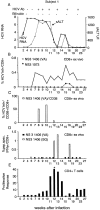Determinants of viral clearance and persistence during acute hepatitis C virus infection
- PMID: 11714747
- PMCID: PMC2193681
- DOI: 10.1084/jem.194.10.1395
Determinants of viral clearance and persistence during acute hepatitis C virus infection
Abstract
The virological and immunological features of hepatitis C virus (HCV) infection were studied weekly for 6 months after accidental needlestick exposure in five health care workers, four of whom developed acute hepatitis that progressed to chronicity while one subject cleared the virus. In all subjects, viremia was first detectable within 1-2 weeks of inoculation, 1 month or more before the appearance of virus-specific T cells. The subject who cleared the virus experienced a prolonged episode of acute hepatitis that coincided with a CD38+ IFN-gamma- CD8+ T cell response to HCV and a small reduction in viremia. Subsequently, a strong CD4+ T cell response emerged and the CD8+ T cells became CD38- and started producing IFN-gamma in response to HCV, coinciding with a rapid 100,000-fold decrease in viremia that occurred without a corresponding surge of disease activity. Chronic infection developed in two subjects who failed to produce a significant T cell response and in two other subjects who initially mounted strong CD4+ T cell responses that ultimately waned. In all subjects, viremia was higher at the peak of acute hepatitis than it was when the disease began, and the disease improved during the viremia. These results provide the first insight into the host-virus relationship in humans during the incubation phase of acute HCV infection, and they provide the only insight to date into the virological and immunological characteristics of clinically asymptomatic acute HCV infection, the commonest manifestation of this disease. In addition, the results suggest that the vigor and quality of the antiviral T cell response determines the outcome of acute HCV infection, that the ability of HCV to outpace the T cell response may contribute to its tendency to persist; that the onset of hepatitis coincides with the onset of the CD8+ T cell response, that disease pathogenesis and viral clearance are mediated by different CD8+ T cell populations that control HCV by both cytolytic and noncytolytic mechanisms, and that there are different pathways to viral persistence in asymptomatic and symptomatic acute HCV infection.
Figures




References
-
- Alter, M.J., H.S. Margolis, K. Krawczynski, F.N. Judson, A. Mares, W.J. Alexander, P.Y. Hu, J.K. Miller, M.A. Gerber, R.E. Sampliner, et al. 1992. The natural history of community-acquired hepatitis C in the United States. The Sentinel Counties Chronic non-A, non-B Hepatitis Study Team. N. Engl. J. Med. 327:1899–1905. - PubMed
-
- Cerny, A., and F.V. Chisari. 1999. Pathogenesis of chronic hepatitis C: immunological features of hepatic injury and viral persistence. Hepatology. 30:595–601. - PubMed
-
- Chang, K.M., B. Rehermann, and F.V. Chisari. 1997. Immunopathology of hepatitis C. Springer Semin. Immunopathol. 19:57–68. - PubMed
-
- Rehermann, B., and F.V. Chisari. 2000. Cell mediated immune response to the hepatitis C virus. Curr. Top. Microbiol. Immunol. 242:299–325. - PubMed
Publication types
MeSH terms
Substances
Grants and funding
LinkOut - more resources
Full Text Sources
Other Literature Sources
Medical
Molecular Biology Databases
Research Materials

